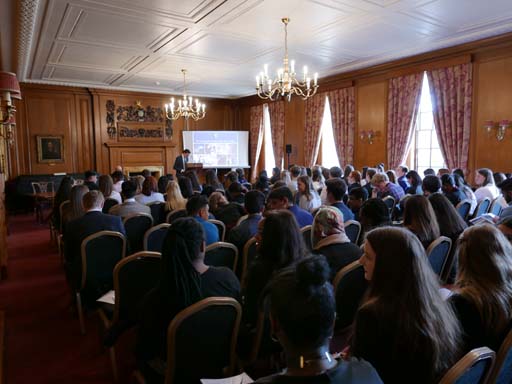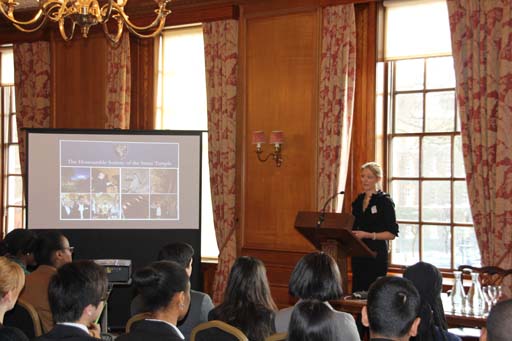Use 'Print preview' to check the number of pages and printer settings.
Print functionality varies between browsers.
Printable page generated Sunday, 30 November 2025, 10:22 AM
Planning an outreach session
Introduction
These resources are designed to help you – as a barrister or a judge – design and deliver sessions about your work and the legal profession to young people aged 14–16 in schools, colleges and other community settings.
Planning an outreach session is divided into four sections:
Where to start from.
Designing your session.
Structuring your session.
Delivering your session.
 Keeping two windows open on this course
Keeping two windows open on this course
Throughout this online course you activate links that navigate you away from the main learning pathway on to a side path of related content. It is recommended that you hold down the Crtl button on your keyboard and click on the link to open the side path in a new window.
In this way, you can keep this learning pathway open in one window and view the new side path content in a separate window.
1 Where to start from
When beginning to plan a session, it is important to think about the starting point of your audience.
In other words, you need to consider:
What they already know
What they want to know.
Then you can tailor your session to meet their needs effectively. Often the event organiser will be able to assist you with this information, so it is worth having a chat with them to find out as much as you can about your particular audience.
You may have children of your own or relatives in the 14–16-year age bracket, or you may have other experience of this age group from other contexts, for example, volunteer youth work. If so, you can draw on your understanding to help you start planning your session.
What is a barrister…?
We asked two 14–16-year olds the above question. Here are their responses.
‘A barrister gives opinions on legal stuff, like telling you if you’ve broken the law or not’ (Will aged 16).
‘Something to do with law….?’ (Annie aged 14).
Below is some information on 14–16-year olds that you may find helpful in providing context for your session:
Law is not part of the National Curriculum of England, Wales, Scotland, or Northern Ireland, although pupils may undertake law at GCSE or A Level. This means that the majority of 14–16-year olds will not have studied law. However, they may have been introduced to aspects of law through their studies of other subjects, such as Citizenship.
Schools have a duty to secure independent careers advice for children in this age bracket and should have a clear careers strategy in place. However, there is some evidence that in the past the quality of provision has been variable. It may also have focused more on transitions into post-16 education than long-term career aspirations.
14–16-year olds are likely to have gained at least some of their perceptions about barristers, and the legal profession more generally, from popular culture, for example, television shows such as Judge Rinder, Suits and Better Call Saul. They may also be aware of individuals and cases from social media, such as the Secret Barrister’s twitter account.
2 Designing your session
This section contains a lesson planner to help you construct a plan for your session.
Use the Activity Record to create your lesson planner
Everything that you type into the free text boxes below and throughout this course can be downloaded or printed as an Activity Record at any point during this course.
You access this Activity Record through the My Profile button (click on the blue button at the top of this page).
In this way, you can create a downloadable or printable lesson planner based on your inputs throughout this course.
Part 5 Number of people in the audience
Click on the relevant box below to get advice on how to handle different audience numbers.
Part 6 Duration of the session
Click on the relevant box below to get advice on how to handle different durations of sessions.
3 Structuring your session
Working through section 2 will have already given you some ideas on how to structure your session, based on audience size and session length.
This section provides tips on a structure drawn from the authors’ experience as educators:
Time permitting, it is a good idea to begin with a ‘warm up’ activity to engage your audience with your topic. This can be a simple question, for example, ‘Give three words you associate with barristers’. Alternatively, you could use a visual aid, for example, a slide with some famous legal professionals for the audience to name. You could even play a video clip to encourage discussion.
Use topical examples from the news to illustrate the points you are making. Alternatively, use examples which 14–16-year olds are likely to have come across, for example, if discussing contract law you could discuss entering into mobile telephone contracts. If discussing privacy, you could use policies on social media as examples.
Avoid ‘lecturing’ for longer than 15 minutes without building in some form of audience interaction. This could be a question to the audience, a quick quiz or even a game, for example, ‘guess the type of law from the picture’.
Time permitting, try to build in some interactive activities to check your audience has understood the key points you are making. As above, this could be via questions, quizzes or games.
Think about using visual props and aids to illustrate the points you are making. This could be slides, excerpts from videos or physical props, such as your wig and gown.
In longer sessions, use small group activities to break up the session. These could include oral discussions or even written work. Remember to factor in five minutes to explain the activity and allocate groups and time at the end for the groups to feedback on what they have been doing.
Time permitting, build in plenty of time for questions from the audience. You should leave time at the end, but if possible it is good to pause during the session and check for questions as you go along.
Leave your audience with a follow-up action or reflection to build on your session. For example, you could ask them to go away and identify a story involving the law in a newspaper or research a question about the process of training as a barrister.
Provide your audience with details of where to go with follow-up questions. This may be the Inner Temple website, the Bar Standards Board website or their Careers Advisor. Providing the session organiser with the details beforehand will make it easier to disseminate this information.
4 Delivering your session
Even when you are a seasoned advocate, delivering a session to a different and younger audience can feel challenging, even daunting.
This section provides tips on a structure drawn from the authors’ experience as educators:
Have some prompts or cue cards to help you remember what you want to say. Alternatively, you could use slides to keep you on track. However, avoid writing a full ‘script’ for the session as it could sound stilted and awkward.
Wear a watch and keep an eye on the time. Have a ‘back up’ plan, for example, some additional questions or an extra activity, which you can use if you get through your planned session faster than you anticipate or if something goes wrong with any technology involved. Also, have a plan for aspects of the session you can ‘drop’ or shorten if you are running over-time.
Don’t be afraid of silences. It can take audience members a while to pluck up the courage to contribute, so make sure you give them time to formulate their responses before moving on. Similarly, if setting small group activities, don’t jump in to direct a group too quickly. Given them a few minutes to start on the task independently.
Know your limits. It is likely there will be a teacher or other observer in the session who can help if issues arise with discipline. You can refer to them if you feel uncomfortable at any point.
Be yourself. Your audience will want to know about you and your experience. Having someone friendly and approachable speak to them is likely to influence their impressions of barristers long after the detail of your session has been forgotten.
| It is recommended that you hold down the Crtl button on your keyboard and click on the link below to open it in a new window. |
This downloadable document Planning an outreach session – suggestions for activities and games has a variety of activities to use during your session. You can cut and paste from it or use it in any way you find useful.
Conclusion
We hope you have found this course useful.
You are now able to identify key characteristics influencing the design and structure of an outreach session. You have also reflected on the most appropriate ways in which to deliver an outreach session.
If you have any further questions on planning an outreach session you can contact the Inner Temple’s Education and Training Team on education@innertemple.org.uk.
| It is recommended that you hold down the Crtl button on your keyboard and click on the link below to open it in a new window. |
Finally, you can also find a lot of useful information on the Inner Temple website.
Acknowledgements
Grateful acknowledgement is made to the following sources:
Every effort has been made to contact copyright holders. If any have been inadvertently overlooked the publishers will be pleased to make the necessary arrangements at the first opportunity.
Important: *** against any of the acknowledgements below means that the wording has been dictated by the rights holder/publisher, and cannot be changed.
302736: Collection image: The Honourable Society of the Inner Temple
328305: Banner image: The Honourable Society of the Inner Temple
328306: Introduction (Lecture): The Honourable Society of the Inner Temple
312730: Introduction: (Planning): Sergey Nivens/Shutterstock
312732: Section 1 (Where to start): Daniil Peshkov / 123RF
328361: Section 3 (Structuring): ismagilov / iStock / Getty Images Plus
328307: Section 4 (Presenting): The Honourable Society of the Inner Temple




